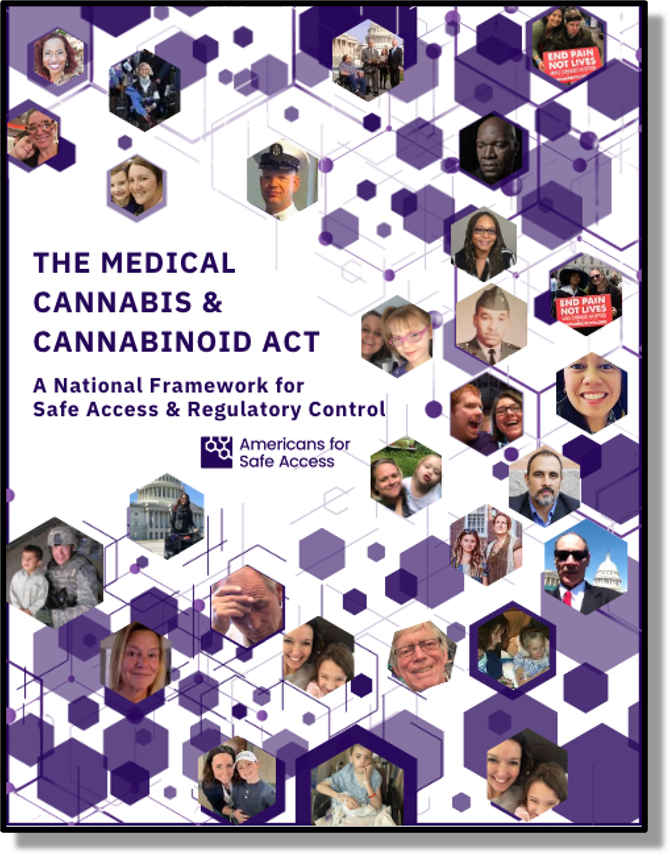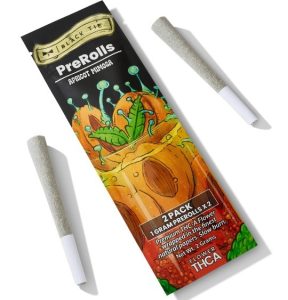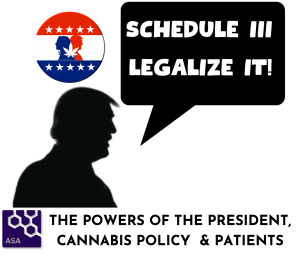Department of Justice Puts Cannabis Spotlight Back on the Plant and Patients

On Thursday, May 16th, 2024, President Biden publicly praised the move to reclassify cannabis to Schedule III. The Department of Justice (DOJ) quickly followed with a press release announcing their proposed rule to the Federal Register, titled,“Proposed Rule Seeks to Move Marijuana from Schedule I to Schedule III, Emphasizing its Currently Accepted Medical Use in Treatment in the United States.”
The DOJ’s 92-page rationale is now available for review. Once posted, it will open a 60-day public comment period.
It is heartening to see the Department of Justice bringing the conversation about cannabis scheduling back to the medical use of cannabis and patients. ASA views rescheduling as a game changer for patients & advocates working to close the gap between politics & medicine.
ASA has been working on changing the classification of cannabis for over 22 years, including filing a rescheduling petition with a coalition of patients in 2003, suing the DEA to move a rescheduling petition to a decision (ASA vs DEA), participating in successful efforts to reschedule cannabis at the United Nations, and more recently advising the FDA in the current rescheduling effort.
While Schedule III does not close the book on safe access for patients, it closes the decades-long chapter for advocates on proving“ if cannabis has medical value” and opens the final chapter on “how can patients safely access cannabis.”
Americans for Safe Access is advocating for comprehensive federal legislation that would create a new schedule for cannabis (Schedule VI) and an oversight agency in Health and Human Services (HHS).
The proposed rule change is not black and white, and the upcoming road ahead to a final ruling promises twists and turns. While patients have not been the focus of much of the news coverage on the rescheduling process, they are at the center of the journey to this groundbreaking end to 50+ years of prohibition of cannabis.

KEY TAKE AWAYS:
A. THE PROPOSED RULE:
AMEND § 1308.11 SCHEDULE I. –(d) Hallucinogenic substances. Unless specifically excepted or unless listed in another schedule, any material, compound, mixture, or preparation, which contains any quantity of the following hallucinogenic substances, or which contains any of its salts, isomers, and salts of isomers whenever the existence of such salts, isomers, and salts of isomers is possible within the specific chemical designation (for purposes of this paragraph only, the term “isomer” includes the optical, position and geometric isomers).
BY REMOVING
paragraph(d)(23)-(23) Marihuana 7360
AND
paragraph (d)(58)- (58) Marihuana Extract 7350 Meaning an extract containing one or more cannabinoids that has been derived from any plant of the genus Cannabis, containing greater than 0.3% delta-9-tetrahydrocannabinol on a dry weight basis, other than the separated resin (whether crude or purified) obtained from the plant.
CHANGING:
(redesignating paragraphs (d)(24) through (d)(104) as (d)(23) through (d)(102), respectively. )
2. AMEND § 1308.11 BY REVISING THE RENUMBERED PARAGRAPH (D)(30) TO READ AS FOLLOWS:
(31) (30) Tetrahydrocannabinols 7370
(i) Meaning tetrahydrocannabinols, except as in paragraph (d)(31)(30)(ii) and (iii) of this section, naturally contained in a plant of the genus Cannabis (cannabis plant), as well as synthetic equivalents of the substances contained in the cannabis plant, or in the resinous extractives extracts of such plant, and/or synthetic substances, derivatives, and their isomers with similar chemical structure and pharmacological activity to those substances contained in the plant, such as the following: 1 cis or trans tetrahydrocannabinol, and their optical isomers 6 cis or trans tetrahydrocannabinol, and their optical isomers 3, 4 cis or trans tetrahydrocannabinol, and its optical isomers
(Since nomenclature of these substances is not internationally standardized, compounds of these structures, regardless of numerical designation of atomic positions covered.)
(ii) Tetrahydrocannabinols does not include any material, compound, mixture, or preparation that falls within the definition of hemp set forth in 7 U.S.C. 1639o.
(iii) Tetrahydrocannabinols does not include any substance that falls within the definition of marijuana set forth in 21 U.S.C. 802(16).
3. AMEND § 1308.13 BY ADDING NEW PARAGRAPHS (H), (I), AND (J) TO READ AS FOLLOWS:
1308.13 Schedule III.
(h) Marihuana Marijuana, as defined in 21 U.S.C. 802(16).
(i) Marihuana Marijuana Extract, meaning an extract containing one or more cannabinoids that has been derived from any plant of the genus Cannabis, containing greater than 0.3 percent delta-9- tetrahydrocannabinol on a dry weight basis, other than the separated resin (whether crude or purified) obtained from the plant.
(j) Naturally Derived Delta-9-Tetrahydrocannabinols.
Meaning those delta-9-tetrahydrocannabinols, except as in paragraphs (j)(ii) and (j)(iii) of this section, that are naturally contained in a plant of the genus Cannabis (cannabis plant).
Naturally derived delta-9-tetrahydrocannabinols do not include any material, compound, mixture, or preparation that falls within the definition of hemp set forth in 7 U.S.C. 1639o.
Naturally derived delta-9-tetrahydrocannabinols do not include any delta-9- tetrahydrocannabinols contained in substances excluded from the definition of marijuana as set forth in 21 U.S.C. 802(16)(B) (ii)
 Current Statute Citations:
Current Statute Citations:
7 U.S.C. §1639o. Definitions (1) Hemp- The term “hemp” means the plant Cannabis sativa L. and any part of that plant, including the seeds thereof and all derivatives, extracts, cannabinoids, isomers, acids, salts, and salts of isomers, whether growing or not, with a delta-9 tetrahydrocannabinol concentration of not more than 0.3 percent on a dry weight basis.
21 U.S.C. 802 (16)(A) Subject to subparagraph (B), the terms “marihuana” and “marijuana” mean all parts of the plant Cannabis sativa L., whether growing or not; the seeds thereof; the resin extracted from any part of such plant; and every compound, manufacture, salt, derivative, mixture, or preparation of such plant, its seeds or resin.
(B) The terms “marihuana” and “marijuana” do not include-
(i) hemp, as defined in section 1639o of title 7; or
(ii) the mature stalks of such plant, fiber produced from such stalks, oil or cake made from the seeds of such plant, any other compound, manufacture, salt, derivative, mixture, or preparation of such mature stalks (except the resin extracted there from), fiber, oil, or cake, or the sterilized seed of such plant which is incapable of germination.
B. UNREGULATED SCHEDULE III PRODUCTS ARE STILL ILLEGAL
Quote from DOJ rationale.
“If marijuana is transferred into schedule III, the manufacture, distribution, dispensing, and possession of marijuana would remain subject to the applicable criminal prohibitions of the CSA. Any drugs containing a substance within the CSA’s definition of “marijuana” would also remain subject to the applicable prohibitions in the Federal Food, Drug, and Cosmetic Act (“FDCA”).”
C. DEA TEEING UP FOR AN ADMINISTRATIVE HEARING
FROM DOJ RATIONALE FOR PROPOSED RULE
“DEA anticipates that updated epidemiological survey data since 2022 may be appropriate for consideration”
“DEA anticipates that additional data on other marijuana constituents, routes of administration of marijuana, and the impact on ∆9-THC potency may be appropriate for consideration.”
“DEA anticipates that additional information arising from this rulemaking will further inform the findings that must be made to reschedule marijuana, including with respect to this factor. DEA also notes that, according to the World Health Organization, cannabis is globally the most commonly used psychoactive substance under international control.”
“DEA anticipates that additional psychic or physiological dependence liability may be appropriate for consideration.”
“DEA believes that additional data on marijuana’s pattern of abuse may be appropriate for consideration in assessing this factor.”
“DEA anticipates that additional data on diversion from State programs and DEA-registered manufacturers may aid in a determination of whether diversion is taking place. “
“DEA anticipates that additional data on seizures of marijuana by law enforcement, cannabis-related ED visits, as well as updated epidemiological survey data since 2022, may be appropriate for consideration.”
“DEA anticipates that additional data on other marijuana constituents, routes of administration of marijuana, and the impact on ∆9-THC potency may be appropriate for consideration.”
“DEA believes that additional data on marijuana’s pharmacological effects may be appropriate for consideration in assessing this factor.”
“DEA believes that additional information arising from this rulemaking will further inform the findings regarding the appropriate schedule for marijuana. DEA has maintained an active review of the scientific literature addressing marijuana with a focus on how it relates to the scientific and medical evaluation and informs any updates to the eight-factor analysis. In addition to HHS’s scientific and medical determinations, which are binding until the issuance of this NPRM and which must be accorded significant deference throughout the rulemaking, DEA believes that factual evidence (including scientific data) and expert opinions, including additional data regarding different forms, formulations, and delivery methods for marijuana, as well as evidence regarding the effects of marijuana at various dosages or concentrations, may be relevant.”
“DEA also believes that additional information regarding the scope, duration, and significance of marijuana abuse may be appropriate for consideration in assessing this factor.”
D. WHAT’S NEXT
- DOJ Posts Proposed Rule
- 60 Days of Public Comment
- DEA Responds to all public comments.
- DEA will decide to move forward with an administrative hearing. Findings are not binding.
- DOJ will make Final Rule
- Stakeholders will have 60 days to ask for judicial rule (lawsuits). Rescheduling could be put on hold until cases are decided.
E. WHAT WILL SCHEDULE III MEAN?
- SCHEDULE III will have little to no impact on the current U.S. cannabis market
- Unregulated Schedule III substances are federally illegal. Cultivating, manufacturing, &/or distributing these substances outside regulatory process is referred to as trafficking & carries steep criminal penalties.
- After rescheduling, cannabis products from state medical cannabis programs will NOT require prescriptions & will NOT become federally legal without guidance from Congress.
- Under Schedule III, status 280E would no longer apply, but because state-licensed cannabis businesses would still be operating outside federal law, it is questionable that they would be allowed tax deductions for business expenses without Congressional action.
Additional Resources:
ASA’s Model Federal Legislation
Background on Scheduling Effort



